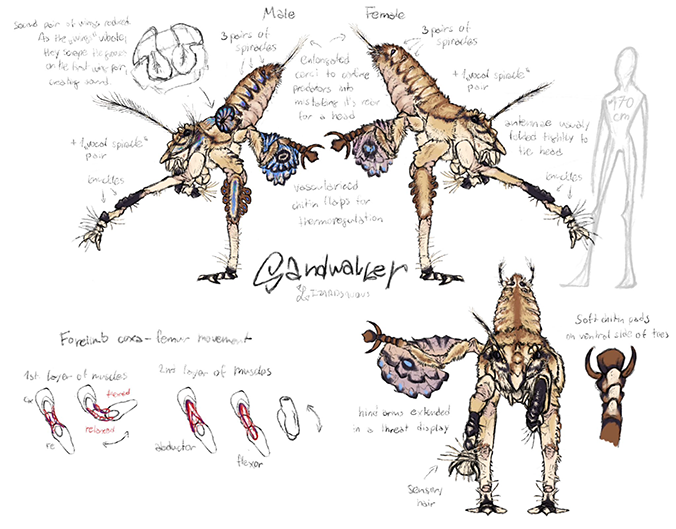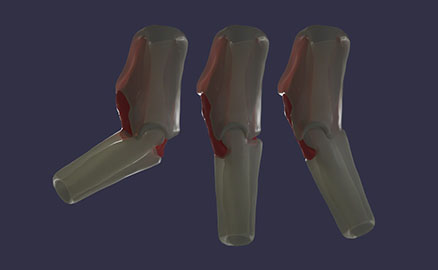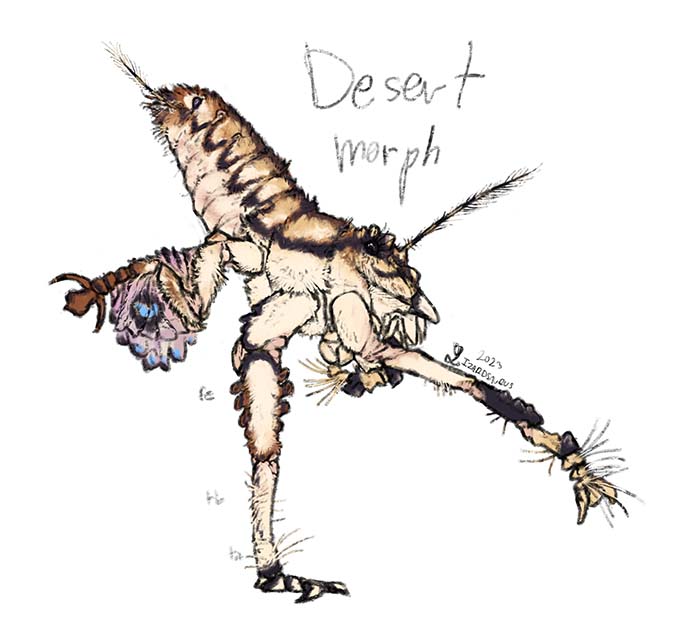Sandwalker


Description
The most notable thing about sandwalkers is that they're bipedal, standing on the second pair of their limbs, while the first one assists during feeding and the third one's main purpose is thermoregulation and balance. Both the first and third pair of legs are used for defense. First pair of limbs also manifests itself during smelling or tasting, as it's covered in long follicles on which the taste buds are located. Although both sexes are capable of sound production through some of their spiracles, only males can stridulate thanks to their specialized organ (see Courtship and Mating). Their vocalizations range from hissing to trumpet-like noises, and in the case of males, even humming and chirping. Since their blood is copper based, it's blue when oxygenated and transparent when de-oxygenated.
Evolution
Their ancestor, archiblatta hoeveni, a large species of cockroach, started growing even larger after being isolated on small islands with almost no vertebrates. Due to that and some genetic modification, they developed more powerful lungs, complex vascular system and copper based blood for more efficient oxygen transportation. This allowed them to grow even larger and adapt to ecological niches never taken by a quaternary insect. They spread and diversified, developing even more complex support structure. Now, 60 million years after the extinction of humans, this diverse group of animals which the sandwalker belongs to, is called the headless. They live in the continent created by Africa, Europe, Asia and lastly Australia (from which the headless have spread) colliding together. Adult female sandwalkers can reach the height of 180cm or 6' and weight up to 65kg (143lbs), males being slightly smaller, reaching the height of 170cm, or 5'2'' to 5'5'' and weighting up to 55kg (121lbs). The height is measured at the highest point of te abdomen.
Distribution and Habitat
As the name might suggest, sandwalkers live in arid and semi-arid environments of the western (african) part of [afroeuroaustralasia]. They are well adapted for dealing with extremely hot weather and are capable of walking very long distances to reach oases. To escape the heat, they often burrow in the sand, despite being as tall as a person.

Ecology and Diet
These animals are gregarious, enjoying the company of other non-predatory creatures. They form loose, unorganised groups of only few individuals, which often migrate between several different groups. They are known to travel alone as well, however. They are somewhat generalist, being able to thrive in various types of environments, despite their clear adaptation to the extreme desert climate.
Sandwalkers are omnivorious, mostly feeding on plant roots, which they dig up using their shovel-like middle claw on their forelimbs, and small animals, which they stun with quick blows from solid, chitin knuckles also located on their front amrs. Sandwalkers are generaly not picky and would eat about anything, but their preferred food are desert berries, eating them and dispersing the plant's seeds throughout the desert.
Courtship and Mating
Sexually mature males, which are smaller and more colourful than females, possess a stridulation organ on their backs that evolved from wings. Females lack this organ completely, which is an ancestral condition since archblatta hoeveni females do not possess wings either. When a male wants to mate, he will get very close to a female of his liking, walking next to her with the same tempo, copying her movements while quietly humming and chirping. If the female does not like his serenade, she'll make a 90° turn away from him. If the male is persistant and makes the female too annoyed, she will make this turn towards him and give him a push as a warning that next time, she might punch him with her powerful forelimbs. If she does like it though, she'll start to randomly slow down and speed up. The male needs to sync with her in order to impress her. If everything goes well, the female will turn around, walking backwards behind the male. She will still test the male'saccurate reactions by slowing down and speeding up, until she slightly bends her abdomen down, which is a signal for the male to mate with her. At this phase, the male slows down untill his abdomen is touching he female's and the two of them mate while still walking. Roughly two weeks after fertilization, the female will lay an ootheca which she attaches to her abdomen's underside. There is a chance that she might intentionaly drop it if she feels seriously threatened.